Cool Jobs: Science deep beneath the waves
These scientists explore the sea’s mysterious depths — from ‘zombie worms’ to mega-waves
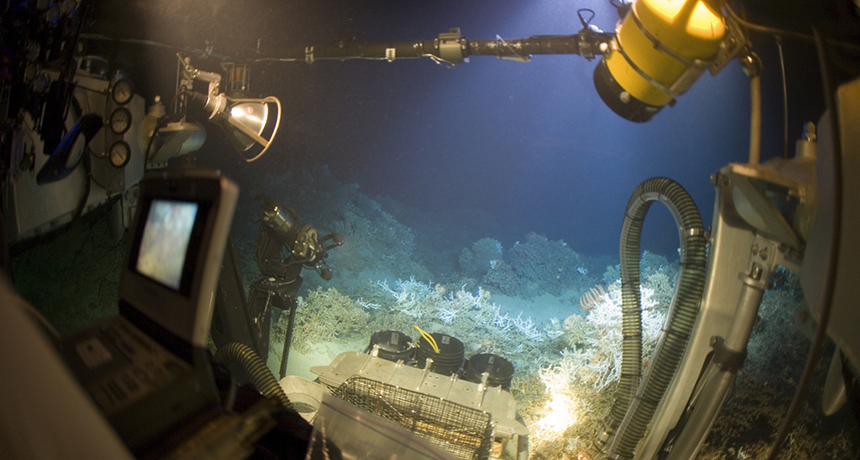
To reach the deepest depths of the oceans, scientists must rely on rovers to take them there — or to do the exploring as they remain atop the waves.
Steve Ross, UNC-W/NOAA Office of Ocean Exploration/Flickr (CC-BY 2.0)
By Ilima Loomis
Looking through the cameras of a remote-controlled submarine, Nicholas Higgs can see the bottom of the ocean, far below. The camera’s light sweeps through the black water, illuminating a flat, silty seafloor. Suddenly the spotlight shines on a huge skeleton. Strange, alien-looking animals cover it. Higgs has found what he was looking for: a whale fall.
He normally works in England out of Plymouth University. A marine biologist, Higgs is deputy director of its Marine Institute.
More than 60 percent of Earth’s surface is deep underwater — so deep, the sun’s light can’t reach it. Huge mountains rise from the seafloor. Chasms deeper than the Grand Canyon shelter microbial life that must survive on what nothing else wants to eat. Animals live out their lives in near-freezing, pitch-black ecosystems.
Or so it seems. Scientists actually know very little about this part of our world, how it works and the creatures living here. “It’s the largest habitat on the planet,” Higgs says.
But to date, he notes, “We’ve explored less than five percent of it — less than one percent in extreme detail.”
Scientists who study the deep ocean are constantly learning new things and discovering surprises. They also face unique challenges working in such a remote and deep environment: darkness, near-freezing temperatures, extreme pressures and even the occasional curious whale. But by probing this mysterious undersea-scape, they can gain new insights into our planet, other species and the nature of life itself.
Whale falls and zombie worms
Imagine living on the bottom of the ocean. With no sunlight, plants cannot grow. Food is hard to find. So you swim around, scouting for edible bits in the seafloor mud. Then out of nowhere, a gigantic dead body cascades down from above.
Woohoo! It’s party time!
This is what scientists call a whale fall. As the carcass of a whale sinks to the sea floor, it becomes an instant feast for animals of the deep. So many come to dine that the whale’s body becomes a new ecosystem — one that can last for years, even decades.
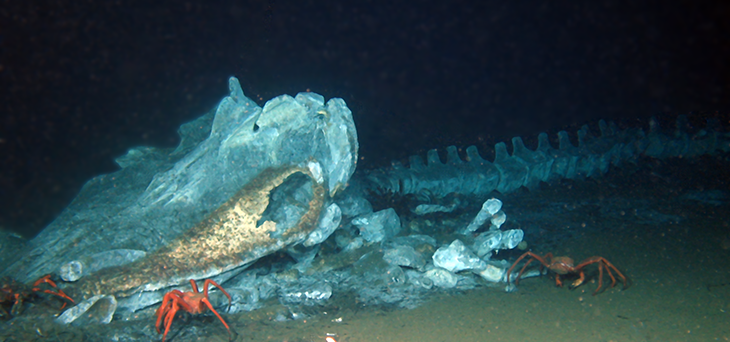
The first to chow down are scavengers. These include sharks and slimy hagfish. They’ll dig into the rotting flesh. Then worms, shrimp and other invertebrates move in. They’ve come to pick up bits of meat and to nibble on the bones. Later, bacteria take over. They make energy from chemical reactions using a process called chemosynthesis (KEE-mo-SIN-the-sis). Finally, the whale’s skeleton becomes a structure within which some animals build their homes.
Higgs has studied all of these communities of creatures.
Sometimes scientists exploring the ocean floor will stumble across a whale carcass by accident. Other times, they find a dead whale that has washed ashore. They might tow it out to sea and sink it on purpose. Then they can study the organisms that come in to recycle the dead.
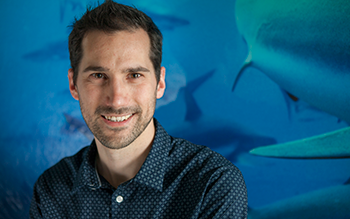
Higgs is part of a team that has cruised to a whale fall aboard a research ship. There, they drop an underwater robot overboard to study the carcass. The robot stays connected to the ship with a tether. Scientists steer the robot to the whale fall, then use the submersible’s cameras, sensors, robotic arm and other tools to investigate. Onboard vacuums can even suck up small sea creatures for study back on the boat or in the lab.
One creature found at whale falls particularly interests Higgs. It is a weird worm from the genus Osedax. These worms eat whale bones. But they don’t have mouths or digestive systems. Instead, they grow rootlike extensions into the bone and dissolve it. By studying marine fossils, Higgs and other scientists have learned that these “zombie worms” have been around at least 100 million years. Yet until 2004 they were unknown to science.
That’s one reason Higgs loves exploring the deep sea.
“It’s one of the last frontiers for discovery on the planet,” he says. “On the one hand, it’s a very difficult environment to study. But what that means is you’re usually finding new things when you go down there. The more samples you get, the more new species you find.”
Small but mighty
A portion of the seafloor may experience a whale fall only once in a blue moon. When it does, a feast follows. For the rest of the time, though, the only food that makes it that far down is the tough stuff that no other animal wants. These might be the material that forms crustacean shells or the cells of plant fibers.
“It can be really recalcitrant stuff,” says Doug Bartlett. “So you have to have superbugs down there to make use of it.” He should know. Bartlett is a deep sea microbiologist at the Scripps Institution of Oceanography at the University of California, San Diego.
He focuses on microbes in the hadal zone. It’s the deepest part of the ocean, found at the bottom of sea-floor trenches more than 6,000 meters (3.7 miles) deep. Microbes here subsist on food no other organisms can digest. They also must survive pressures as high as 1,125 kilogram-force/square centimeter (16,000 pounds per square inch) in near-freezing temperatures and total darkness.
Because deep ocean trenches are isolated from one another, the animals within each evolve to be unique. A trench is like an underwater island, with its own distinct species of crustaceans, jellies and microbes. In these trenches, scientists can see how evolution has played out in extreme conditions. “We’re learning about the outer boundaries in which life can exist,” Bartlett explains.
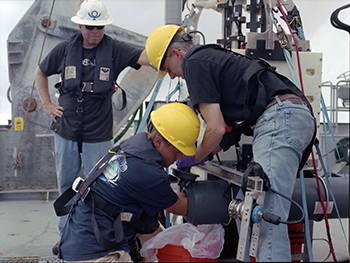
The conditions deep in a trench are too extreme for humans. So, like Higgs, Bartlett uses an underwater robot to collect samples of water, silt and marine organisms from the ocean floor. This remote-controlled device brings samples up to the ship for study. Larger animals like fish and invertebrates die before they reach the surface. They can’t survive the drop in pressure and rise in temperature. But some microbes can survive a trip to the surface. Bartlett keeps them in special dark, cold, pressurized containers. That way, he can continue to grow and study them while they’re alive.
Scientists hope that by studying these microbes they might discover something new that could be useful. This might be anything from a microbe that breaks down plastic to one that could be used to make new cancer-fighting drugs.
Learning how life survives in such extreme conditions also interests scientists who think about what life might exist on other worlds within our solar system. One example is Jupiter’s moon Europa. Scientists now believe it has a deep, watery ocean. “It may be decades before we get samples back from Europa,” Bartlett says. “But we can go to an ocean setting in a Europa-like environment on Earth and see what life is like there.”
Story continues below image.
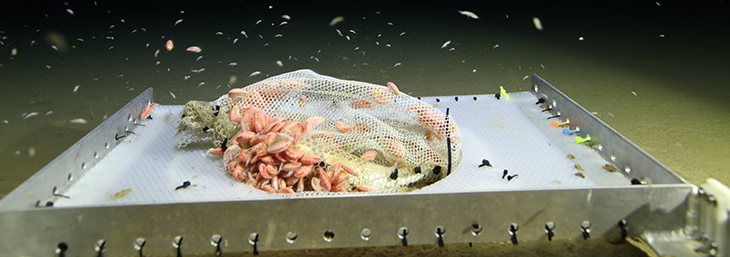
Waves down deep
You may have watched winds whipping up whitecaps on big lakes or the ocean. But where does all that energy go? Those winds don’t just stir up the water’s surface. It turns out that they create waves that can travel to the floor of even the deepest oceans.
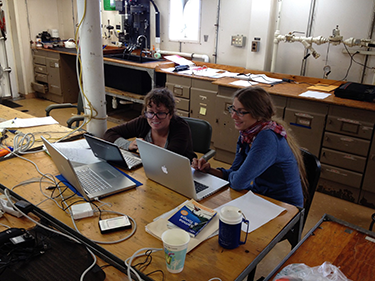
These near-inertial (In-UR-shul) waves — ones that flow through the interior of the ocean — are what Kelly Pearson studies. She’s a physical oceanographer and PhD candidate at the University of Hawaii at Manoa.
On one research trip, she studied how water moves through the Samoan Passage. This is a gap between two underwater mountains north of the island nation of Samoa. Here, cold water from Antarctica flows along the ocean floor into the North Pacific. Researchers were excited to observe near-inertial waves more than 5,000 meters (3.1 miles) below the ocean’s surface. No one knew they could travel that deeply!
So what if they do? Near-inertial waves contribute to ocean mixing. When rain falls on the ocean’s surface, these waves help stir it into the salty water below. And as climate change warms the world’s oceans, understanding the movement of near-inertial waves could help scientists better predict how quickly that warm water will get mixed into the cold waters at the very bottom of the sea.
To study this phenomenon, Pearson joins other scientists on research cruises to the Samoan Passage. They travel to a remote part of the ocean, then drop long lines that sink to the bottom. They attach instruments that measure ocean qualities such as saltiness, temperature, pressure and water currents. On one trip, Pearson recalls, “when we were putting [the instrument] in, some whales came and started playing with the instrument, pushing it up and down the rope with their nose…We were like, ‘This is so cool! But also don’t break our instrument!’”
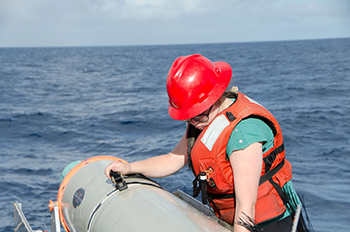
A cruise can last 30 to 40 days. Throughout, there is no cell-phone service. There also is no regular internet access.
It can be hard to be away that long from family, friends and news of the outside world. The scientists plan lots of activities so that they don’t get bored or lonely when they’re not working. There’s a cafeteria, a gym, a library and a movie room on the ship. On one cruise, the scientists held a ping-pong tournament and built themselves a hot tub to pass the time, Pearson says. “It’s a completely different world,” she notes.
Pearson continues learning new things about near inertial waves. Not only are they powerful enough to make it down to the seabed, but they also have enough energy left to “reflect” off the seafloor and start heading back up.
She has also found this takes a long time. According to her observations, some waves took three years to travel from the surface to the seafloor. She won’t be totally certain, however, until other scientists can confirm her results.
Like Higgs, Pearson loves the challenge and mystery of studying the deep sea. “It’s that unknown,” she says. “We don’t know what’s going on down there. There are three people who’ve gone down to the bottom of the ocean at Challenger Deep.” (This is a chasm nearly 11,000 meters [6.8 miles] deep at its lowest point in the Mariana Trench). Those people required special submersibles to do so. And that’s only one quarter as many people as have walked on the moon, she notes.
The deep ocean remains, she says, “one of the last elusive things.”
This is one in a series on careers in science, technology, engineering and mathematics made possible with generous support from Arconic Foundation.







